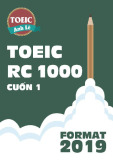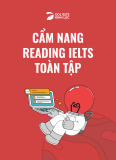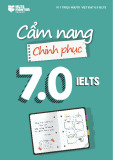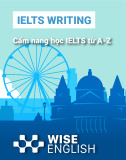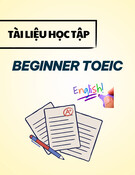VnDoc Tải tài liệu, văn bản pháp luật, biểu mẫu miễn phí
Ẫ Ề Ứ M U Đ THI CH NG CH TI NG ANH THEO KHUNG THAM CHI U Ữ Ạ Ọ Ạ Ỉ Ế Ạ Ạ Ọ Ế Ố
CHUNG CHÂU ÂU T I Đ I H C NGO I NG Đ I H C QU C GIA HÀ N IỘ
SAMPLE TEST SECTION 1 LISTENING COMPREHENSION Time approximately 35 minutes (including the reading of the directions for each part)
In this section of the test, you will have an opportunity to demonstrate your ability to understand conversations and talks in English. There are three parts to this section. Answer all the questions on the basis of what is stated or implied by the speakers you hear. Do not take notes or write in your test book at any time. Do not turn the pages until you are told to do so. Part A
Directions: In Part A you will hear short conversations between two people. After each conversation, you will hear a question about the conversation. The conversations and questions will not be repeated. After you hear a question, read the four possible answers in your test book and choose the best answer. Then, on your answer sheet, find the number of the question and fill in the space that corresponds to the letter of the answer you have chosen.
Sample Answer Listen to an example. On the recording, you hear:
That exam was just awful Oh, it could have been worse. What does the woman mean? (man) (woman) (narrator)
In your test book, you read: (A)
The exam was really awful. It was the worst exam she had ever seen. It couldn't have been more difficult. (B) (C)
VnDoc Tải tài liệu, văn bản pháp luật, biểu mẫu miễn phí
(D)
It wasn't that hard. You learn from the conversation that the man thought the exam was very difficult and that the woman disagreed with the man. The best answer to the question, “What does the woman mean?” is (D), “It wasn't that hard.” Therefore, the correct choice is (D).
1. Carla does not live very far It finished on time. It was about honor.
(B) (C) (D)
(A) away. (B) What Carla said was unjust. (C) He does not fear what anyone says. (D) Carla is fairly rude to others.
2.
She thinks it's an improvement. The fir trees in it are better. It resembles the last one. It is the best the man has ever (A) (B) (C) (D) done.
3. He graduated last in his class. He is the last person in his
He doesn't believe he can
He has finally finished his (A) (B) family to graduate. (C) improve gradually. (D) studies.
4. He's surprised there were five
It was an unexpectedly
He would like to know what
(A) dresses. (B) inexpensive dress. (C) color dress it was. (D) The dress was not cheap.
5.
(A) (B) (C) (D) Leave the car somewhere else. Ignore the parking tickets. Add more money to the meter. Pay the parking attendant.
6. He does not like to hold too
There is no bookstore in his
It's not possible to obtain the
He needs to talk to someone at (A) many books at one time. (B) neighborhood. (C) book yet. (D) the bookstore.
7. (A) It was incomplete.
VnDoc Tải tài liệu, văn bản pháp luật, biểu mẫu miễn phí
(E) It was too long. gift.
8. She needs to use the
Yesterday's physics class
She took some very good
She would like to lend the
9. It s her birthday today. She's looking for a birthday
She wants to go shopping
She wants a new wallet (A) man’s notes. (B) was quite boring. (C) notes in physics class. (D) man her notes. (A) (B) gift. (C) with her dad. (D) for herself.
10.
(A) (B) (C) (D) He prefers cold water. His toes are too big. The pool felt quite refreshing. He didn't go for a swim.
11.
She just left her sister's house. Her sister is not at home. She's not exactly sure where
She doesn't know where (A) (B) (C) her sweater is. (D) her sister lives.
She doesn't have time 12.
She cannot finish the
(A) to complete additional reports. (B) reports that she is already working on. (C) She is scared of having responsibility for the reports. (D) It is not time for the accounting reports to be compiled.
13. He's had enough exercise. He's going to give
He’s going to stay on for
(A) (B) himself a reward for the hard work. (C) quite some time. (D) He would like to give the woman an exercise machine as a
14.
(C) Make an appointment with his dentist (D) He cannot see the huge waves. The waves are not coming in. He would like the woman to
(A) (B) (C) repeat what she said. (D) He agrees with the woman.
15. The exam was postponed. The man should have studied
Night is the best time to study
She is completely prepared (A) (B) harder. (C) for exams. (D) for the exam.
16. Students who want to change
It is only possible to make four
It is necessary to submit the
Problems occur when people (A) schedules should form a line. (B) changes in the schedule. (C) form quickly. (D) don't wait their turn.
17.
(A) (B) (C) (D) In a mine In a jewelry store In a clothing store In a bank
18.
A visit to the woman's family The telephone bill The cost of a new telephone How far away the (A) (B) (C) (D) woman's family lives
19. She hasn't met her new boss yet. She has a good opinion of her
Her boss has asked her about her
Her boss has been putting a (A) (B) boss. (C) impressions of the company. (D) lot of pressure on her.
20. The recital starts in three hours. He intends to recite three
He received a citation on the
He thinks the performance
21. (A) (B) different poems. (C) third of the month. (D) begins at three. (A) (B) Choose a new dentist Cure the pain himself
Ask his dentist about the She thinks she did a good job on (E) right way to brush over again. (B) the exam.
22. It is almost five o'clock. The man doesn't really need
It is a long way to the
It would be better to go (A) (B) the stamps. (C) post office. (D) after five o’clock.
23. The article was placed
The woman must ask
The woman should look
(A) on reserve. (B) the professor for a copy. (C) through a number of journals in the library. (D) He has reservations about the
24. He needs to take a nap. He hopes the woman will
(A) (B) help him to calm down. (C) (D) The woman just woke him up. He is extremely relaxed.
25. She doesn’t think the
She has never before
She never watches the news
She shares the man's (A) news report is false. (B) reported on the news. (C) on television. (D) opinion about the report.
26.
The policy has not yet
(A) Management will offer pay raises on Friday. (B) been decided. (C) (D) The manager is full of hot air. The plane has not yet landed.
27. He doesn't believe that it
The snow had been predicted. The exact amount of snow
He expected the woman to (A) is really snowing. (B) (C) is unclear. (D) go out in the snow.
28. (A) She's going to take the test
She has not yet taken the (E) He needed to take a walk.
30. 29.
She's unhappy with how she did. The door was unlocked. It was better to wait outside. He could not open the door. (A) (B) (C) (D) He nailed the door shut. He is heading home. He hit himself in the head. He is absolutely correct. (C) literature exam. (D) (A) (B) (C) (D)
Part B
Directions; In this part of the test, you will hear longer conversations. After each conversation, you will hear several questions. The conversations and questions will not be repeated. After you hear a question, read the four possible answers in your test book and choose the best answer. Then, on your answer sheet, find the number of the question and fill in the space that corresponds to the letter of the answer you have chosen. Remember, you are not allowed to take notes or write in your test book.
31. The haircut is unusually 35.
This is Bob’s first haircut. Bob doesn’t know who 36. Every evening Every week Every Sunday Every month That she was eightyfive After the haircut, Bob’s hair
32. That a storm was coming That she was under a great It is just what he wanted. He enjoys having the latest That she wanted to become
He dislikes it immensely. He thinks it will be cool in 37. (A) short. (B) (C) gave him the haircut. (D) still touches the floor. (A) (B) style. (C) (D) the summer.
33. (A) (B) (C) (D) (A) years old (B) (C) deal of pressure (D) a weather forecaster In her bones (A) In her ears (B) In her legs (C) In her head (D)
A broken mirror The hairstylist The scissors used to cut his 38. Call his greatgrandmother
(A) (B) (C) hair (D) Piles of his hair
34. "You should become a Help his greatgrandmother
Believe his great
(A) hairstylist." (B) (C) (D) (A) less often (B) Watch the weather forecasts with his greatgrandmother (C) relieve some of her pressures (D) grandmothers predictions about the weather "Please put it back on.” "It’ll grow back.” "It won't grow fast enough."
Part C Directions: In this part of the test, you will hear several talks. After each talk, you will hear some questions. The talks and questions will not be repeated.
After you hear a question, read the four possible answers in your test book and choose the best answer. Then, on your answer sheet, find the number of the question and fill in the space
that corresponds to the letter of the answer you have chosen.
Here is an example.
On the recording, you hear:
Listen to an instructor talk to his class about painting. Artist Grant Wood was a guiding force in the school of painting (narrator) (man)
known as American regionalist, a style reflecting the distinctive characteristics of art from rural areas of the United States. Wood began drawing animals on the family farm at the age of three, and when he was thirtyeight one of his paintings received a remarkable amount of public notice and acclaim. This painting, called “American Gothic, ” is a starkly simple depiction of a serious couple staring directly out at the viewer. Now listen to a sample question. Sample Answer
What style of painting is known as American regionalist? (narrator) In your test book, you read: (A) Art from America s inner cities (B)
(C)
Art from the central region of the United States Art from various urban areas in the United States Art from rural sections of America (D)
Sample Answer What is the name of Wood’s most successful painting? The best answer to the question, “What style of painting is known as American regionalist?” is (D), "Art from rural sections of America." Therefore, the correct choice is (D). Now listen to another sample question. (narrator)
In your test book, you read:
(A) “American Regionalist” (B) “The Family Farm in Iowa” (C) "American Gothic" (D) "A Serious Couple"
The best answer to the question, "What is the name of Wood s most successful painting?" is (C), “American Gothic.” Therefore, the correct choice is (C). Remember, you are not allowed to take notes or write in your test book.
Getting closer to the 39.
Exploring the water’s edge Getting off the tram 43. 40. In a car On a hike On a tram In a lecture hall It means they have big
(B) crocodiles (C) (D) (A) Water Sports Physics (B) American History (C) Psychology (D) It means they like to swim. It means they look like 44. It means they are pretending
41. They are sad. They are warming
42. (A) (B) (C) (D) (A) tears. (B) (C) crocodiles. (D) to be sad. (A) (B) themselves. (C) (D) (A) They are getting rid of salt. They regret their actions. Taking photographs
45.
46. To cut To move fast To steer a boat To build a ship To bring tea from China To transport gold
To trade with the British To sail the American (A) (B) (C) (D) A) (B) to California (C) (D) river system
47. He or she would have shaky
He or she would stop A reading assignment A quiz on Friday A research paper for the 50. Some written homework 48. By staring at the audience By breathing shallowly By thinking about possible
By focusing on what needs
49. He or she would see 51.
He or she would break a (D) knees. (E) breathing. (A) (B) (C) negative outcomes (D) to be done (A) (B) (C) (D) At two o’clock At four o'clock At six o’clock At eight o’clock
(A) (B) (C) end of the semester (D) (A) Writers Actors (B) Athletes (C) (D) Musicians (A) butterflies. (B) leg. (C)
SECTION 2
STRUCTURE AND WRITTEN EXPRESSION
Time 25 minutes
(including the reading of the directions)
Now set your clock for 25 minutes.
This section is designed to measure your ability to recognize language that is appropriate for standard written English. There are two types of questions in this section, with special directions for each type.
Structure
Directions: Questions 115 are incomplete sentences. Beneath each sentence you will see four words or phrases, marked (A), (B), (C), and (D). Choose the one word or phrase that best completes the sentence. Then, on your answer sheet, find the number of the question and fill in the space that corresponds to the letter of the answer you have chosen. Fill in the space so that the letter inside the oval cannot be seen.
Look at the following examples.
Example I
The president the election by a landslide. Sample answer
(A) won
(B) he won
(C) yesterday
(D) fortunately
The sentence should read, "The president won the election by a landslide." Therefore, you should choose (A).
Example II
When the conference? Sample answer
(A) the doctor attended
(B) did the doctor attend
(C) the doctor will attend
(D) the doctors attendance
The sentence should read, "When did the doctor attend the conference?" Therefore, you should choose (B).
Now begin work on the questions.
6. , the outermost layer of skin, is
1. about as thick as a sheet of paper over most of the skin.
It is the epidermis (A)
In the epidermis (B)
The epidermis (C)
The epidermis is (D)
Sam Spade in The Maltese 2. Falcon and Rick Blaine in Casablanca of Humphrey Bogart’s more famous roles.
they are two (A)
two of them are (B)
two of them (C)
are two (D)
3. one The compound microscope has not two lenses.
and also (A)
but (B)
and there are (C)
but there are (D)
During the Precambrian period, in the 4. the Earth's crust formed, and life seas.
first appeared (A)
first to appear (B)
is first appearing (C)
appearing (D)
5.The hard palate forms a partition and nasal passages.
the mouth (A)
between the mouth (B)
is between the mouth (C)
it is between the mouth (D)
(D) the statue should be
Hydroelectric power can be 7. Conditions required for seed germination include abundant water, an adequate supply of oxygen, and 11. produced by and using tidal flow to
run turbines. the temperatures must (A) be appropriate
having
(B) appropriate temperatures
appropriate temperatures (C)
appropriately temperate (D)
When fluid accumulates against
8. the eardrum, a second more insidious type of
(A) otitis media may develop
(B) developing otitis media
the development of (C) otitis media
(D) to develop otitis media
Some general theories of of central
9. motivation motives, from which other motives develop.
(A) identify a limited number
identification of a (B) limited amount
(C) identify a limited amount
identifying a (D) limited number
Before the Statue of Liberty
10. arrived in the United States, newspapers invited the public to help determine where placed after its arrival.
(A) should the statue be
(B) the statue being
(C) it should be the statue
(A) water basins are dammed (B) whose cocoons
(B) damming water basins (C) from cocoons
(C) to dam water basins (D) whose cocoons are from
(D) dams in water basins (E) from whose cocoons
Not only
15. generate energy, but it also produces fuel for other fission reactors. Abraham Lincoln and Jefferson 12. of the Union and the Davis, Confederacy during the Civil War, were both born in Kentucky. (A) a nuclear breeder reactor they were opposing it is a nuclear breeder (A) presidents (B) reactor (B) were opposing presidents does a nuclear breeder (C) opposing presidents (C) reactor
(D) presidents opposed (D) is a nuclear breeder reactor
A stock at an inflated price D.w. Griffith pioneered many 13. is called a watered stock.
as the Hollywood (A) issued 16. of the stylistic features and filmmaking techniques standard.
(B) is issued (A) that established
(C) it is issued (B) that became established
(D) which issued (C) what established
(D) what became established The leaves of the white mulberry silk
14. provide food for silkworms, fabrics are woven. (A)
WRITTEN EXPRESSION
Directions: In questions 1640, each sentence has four underlined words or phrases. The four underlined parts of the sentence are marked (A), (B), (C), and (D). Identify the one underlined word or phrase that must be changed in order for the sentence to be correct. Then, on your answer sheet, find the number of the question and fill in the space that corresponds to the letter of the answer you have chosen.
Look at the following examples.
Example I Sample Answer
The four string on a violin are tuned
A B C D
in fifths.
The sentence should read, "The four strings on a violin are tuned in fifths.” Therefore, you should choose (B).
Example II Sample Answer
The research for the book Roots taking
A B C
Alex Haley twelve years.
D
The sentence should read, “The research for the book Roots took Alex Haley twelve years.” Therefore, you should choose (C).
Now begin work on the questions.
17. Mosquitoes will accepts the malaria parasite at only one stage of the parasite’s A B C
complex life cycle. D
18. The counterpart of a negative electrons is the positive proton. A B D C
19. The ankle joint occur where the lower ends of the tibia and fibula slot neatly around A C D B
the talus.
20. of In the United States and Canada, motor vehicle laws affect the operate C A B
motorcycles as well as automobiles. D
21. The neocortex is, in evolutionary terms, most recent layer of the brain. A B C D
22. There are more than eightyfour million specimens in the National Museum of B A
Natural History’s collection of biological, geological, archeological, and C
anthropology treasures. D
23. George Washington married widow Martha Custis, the couple came to resides After A B C D
at Mount Vernon.
24. At this stage in their development, rubberized asphalt can hardly be classified as
A B C D
cutting edge.
25. Rhesus monkeys exhibit patterns of shy similar to those in humans.
A B C D
26. In space, with no gravity for muscles to work against, the body becomes weakly. A B C D
27. Fort Jefferson, in the Dry Tortugas off the southern tip of Florida, can be reach A B C
only by boat or plane. D
28. A zoom lens produces an inverted real image, either on the film in a camera and on A D C B
the lightsensitive tube of a television camera.
29. Supersonic flight is flight that is faster the speed of sound.
A B C D
30. The Betataken House Ruins at Navajo National Monument is among the largest and A B
most elaborate cliff dwellings in the country. D C
31. It is a common observation that liquids will soak through some materials but not A B C
through other. D
32. The number of wild horses on Assateague are increasing lately, resulting in A B C
overgrazed marsh and dune grasses. D
33. The newsreels of Hearst Metronome News, which formed part of every moviegoers A experience in the era before television, offer an unique record of the events of the B C D 1930s.
34. Unlikely A gas sport balloons, hot air balloons do not have nets. D C B
35. in Massachusetts in 1852, Albert Farbanks has begun making banjos in Boston B C
Born A in the late 1870s. D
36. Dwight David Eisenhower, military officer and thirtyfourth president of the United
A
States, lived in the White House and of least thirtyseven other residences. C D B
37. Methane in wetlands comes from soil bacteria that consumes organic plant matter. A B D C
38. Alois Alzheimer made the first observers of the telltale signs of the disease that today A B
bears his name. C D
39. Edward MacDowell remembers as the composer of such perennial favorites as “To a
 B C D Wild Rose" and “To a Water Lily."
40. Animism is the belief that objects and natural phenomena such as rivers, rocks, and B A wind are live and have feelings. C D
41. Newtonian physics accounts for the observing orbits of the planets and the moons.
A B C D
This is the end of Section 2. If you finish before 25 minutes has ended, check your work on Section 2 only.
SECTION 3
READING COMPREHENSION
Time—55 minutes
(including the reading of the directions)
Now set your clock for 55 minutes.
This section is designed to measure your ability to read and understand short passages similar in topic and style to those that students are likely to encounter in North American universities and colleges.
Directions: In this section you will read several passages. Each one is followed by a number of questions about it. You are to choose the one best answer, (A), (B), (C), or (D), to each question. Then, on your answer sheet, find the number of the question and fill in the space that corresponds to the letter of the answer you have chosen.
Answer all questions about the information in a passage on the basis of what is stated or implied in that passage.
Read the following passage:
John Quincy Adams, who served as the sixth president of the United States from 1825 to 1829, is today recognized for his masterful statesmanship and diplomacy. He dedicated his life to public service, both in the presidency and in the various other political offices that he held. Throughout his political career he demonstrated his unswerving belief in freedom of speech, the antislavery cause, and the right of Americans to be free from European and Asian domination.
Lin e (5)
Example I
To what did John Quincy Adams devote his life? Sample answer
(A) Improving his personal life
(B) Serving the public
(C) Increasing his fortune
(D) Working on his private business
According to the passage, John Quincy Adams "dedicated his life to public service.” Therefore, you should choose (B).
Example II Sample answer
In line 4, the word "unswerving" is closest in meaning to
(A) moveable
(B) insignificant
(C) unchanging
(D)
dipl om atic
The passage states that John Quincy Adams demonstrated his unswerving belief "throughout his career." This implies that the belief did not change. Therefore, you should choose (C).
Now begin work on the questions.
Questions 110
The hippopotamus is the third largest land animal, smaller only than the elephant and
the rhinoceros. Its name comes from two Greek words which mean "river horse." The long name of this animal is often shortened to the easier to handle term "hippo."
The hippo has a natural affinity for the water. It does not float on top of the water;
instead, it can easily walk along the bottom of a body of water. The hippo commonly remains underwater for three to five minutes and has been known to stay under for up to half an hour before coming up for air.
In spite of its name, the hippo has relatively little in common with the horse and
instead has a number of interesting similarities in common with the whale. When a hippo comes up after a stay at the bottom of a lake or river, it releases air through a blowhole, just like a whale. In addition, the hippo resembles the whale in that they both have thick layers of blubber for protection and they are almost completely hairless.
1. The topic of this passage is horse
(D) 4. (A) the largest land animals
(B) the derivations of animal names
(C) the characteristics of the hippo
(D) the relation between the hippo and
the whale
It can be inferred from the 2. passage that the rhinoceros is
(A) smaller than the hippo
(B) equal in size to the elephant
(C) a hybrid of the hippo and the
elephant
(D) one of the two largest types of land
animals
The possessive “Its” in line 2 3. refers to
(A) hippopotamus
(B) elephant
(C) rhinoceros
5. It can be inferred from the passage that the hippopotamus is commonly called a hippo because the word “hippo” is
simpler to pronounce (A)
scientifically more accurate (B)
the original name (C)
easier for the animal to recognize (D)
The word "float” in line 4 is 6. closest in meaning to
(A) sink
(B) drift
(C) eat
(D) flap
7. According to the passage, what is the maximum time that hippos have been known to stay underwater?
(A) Three minutes
(B) Five minutes
(C) Thirty minutes
(D) Ninety minutes
The expression “has relatively little (E) they both breathe underwater
The word “blubber” in line 10 is 8. in common” in line 7 could best be replaced by 10. closest in meaning to (A) has few interactions fat (A) (B) is not normally found metal (B) (C) has minimal experience water (C) (D) shares few similarities skin (D)
The passage states that the hippo 9. The passage states that one way in which a hippo is similar to a whale is that 11. does not they both live on the bottoms of (A) like water (A) rivers
(B) resemble the whale (B) they both have blowholes
(C) have a protective coating they are both named after horses
(C) (D) (D) have much hair
Questions 1119
John Janies Audubon, nineteenthcentury artist and naturalist, is known as one of the
foremost authorities on North American birds. Bom in Les Cayes, Haiti, in 1785, Audubon was raised in France and studied art under French artist JacquesLouis David. After settling on his father’s Line Pennsylvania estate at the age of eighteen, he first began to study and paint birds.
In his young adulthood, Audubon undertook numerous enterprises, generally without a
tremendous amount of success; at various times during his life he was involved in a mercantile business, a lumber and grist mill, a taxidermy business, and a school. His general mode of operating a business was to leave it either unattended or in the hands of a partner and take off on excursions through the wilds to paint the natural life that he saw. His business career came to end in 1819 when he was jailed for debt and forced to file for bankruptcy.
It was at that time that Audubon began seriously to pursue the dream of publishing a
collection of his paintings of birds. For the next six years he painted birds in their natural habitats while his wife worked as a teacher to support the family. His Birds of America, which included engravings of 435 of his colorful and lifelike water colors, was published in parts during the period from 1826 to 1838 in England. After the success of the English editions, American editions of his work were published in 1839, and his fame and fortune were ensured.
12. This passage is mainly about (C)
the works that Audubon published (D) (A) North American birds
(B) Audubon's route to success as a
painter of birds
(E) Audubon's preference for travel
in natural habitats
The word “foremost” in line 13. 1 is closest in meaning to
(A) prior
(B) leading
(C) first paintings
(D) largest The word “pursue” in line 11 is 17. closest in meaning to In the second paragraph, the author 14. mainly discusses (A) imagine
how Audubon developed his (B) share (A) painting (C) follow style (D) deny (B) Audubon’s involvement in a 18. According to the passage, mercantile business Audubon’s paintings
(C) where Audubon went on his were realistic portrayals (A)
excursions used only black, white, and gray (B)
(D) Audubon’s unsuccessful business were done in oils (C)
practices depicted birds in cages (D)
The word "support" in line 13 The word “mode” in line 7 could 19. could best be replaced by 15. best be replaced by
(A) tolerate (A) method
(B) provide for (B) vogue
(C) side with (C) average
(D) fight for (D) trend
It can be inferred from the passage Audubon decided not to continue to 20. that after 1839 Audubon 16. pursue business when
(A) unsuccessfully tried to develop new (A) he was injured in an accident at a
businesses grist mill
continued to be supported by his (B) he decided to study art in France (B) wife he was put in prison because he (C) traveled to Europe (C) owed
(D) became wealthy money
(D) he made enough money from his
Questions 2029
Schizophrenia is often confused with multiple personality disorder yet is quite distinct from it. Schizophrenia is one of the more common mental disorders, considerably more
common than multiple personality disorder. The term “schizophrenia” is composed of roots which mean “a splitting of the mind," but it does not refer to a division into separate and
distinct personalities, as occurs in multiple personality disorder. Instead, schizophrenic behavior is generally characterized by illogical thought patterns and withdrawal from reality. Schizophrenics often live in a fantasy world where they hear voices that others cannot hear, often voices of famous people. Schizophrenics tend to withdraw from families and friends and communicate mainly with the “voices” that they hear in their minds.
It is common for the symptoms of schizophrenia to develop during the late teen years or early twenties, but the causes of schizophrenia are not well understood. It is believed that heredity may play a part in the onset of schizophrenia. In addition, abnormal brain chemistry also seems to have a role; certain brain chemicals, called neurotransmitters, have been found to be at abnormal levels in some schizophrenics.
The paragraph preceding the a division into factions (A) 21. passage most probably discusses (B)
(A) the causes of schizophrenia
(B) multiple personality disorder
(C) the most common mental disorder
(D) possible cures for schizophrenia
22. Which of the following is true about schizophrenia and multiple personality disorder?
(A) They are relatively similar.
One is a psychological disorder, (B) while
the other is not.
(C) Many people mistake one for the
other.
(D) Multiple personality disorder occurs
more often than schizophrenia.
“Disorder” in line 3 is closest in 23. meaning to which of the following?
(A) Disruption
(B) Untidiness
(C) Misalignment
(D) Disease
It can be inferred from the 24. passage that a. “schism" is
(C) a mental disease
(D) a personality trait
(E) a part of the brain
25. What is NOT true about schizophrenia, according to the passage?
(A) It is characterized by separate
and distinct personalities.
(B) It often causes withdrawal
from reality.
(C) Its symptoms include
illogical thought patterns.
Its victims tend to hear voices (D) in their
minds.
According to the passage, how
26. do schizophrenics generally relate to their families?
(A) They are quite friendly with
their families.
(B) They become remote from
their families.
(C) They have an enhanced ability
to understand their families.
They communicate openly (D) with their
families.
(C) medication
(D) effect 27. It can be inferred from the passage that it would be least common for schizophrenia to develop at the age of
(E) age fifteen (A)
The word "abnormal” in line 11 is twenty (B) 29. closest in meaning to twentyfive (C) (A) unstable thirty (D) (B) unregulated The word "onset” in line 11 is (C) uncharted 28. closest in meaning to
(D) unusual start
(A) (B)
Questions 3039
People are often surprised to learn just how long some varieties of trees can live. If
asked to estimate the age of the oldest living trees on Earth, they often come up with guesses in the neighborhood of two or perhaps three hundred years. The real answer is considerably larger than that, more than five thousand years.
The tree that wins the prize for its considerable maturity is the bristlecone pine of California. This venerable pine predates wonders of the ancient world such as the pyramids of Egypt, the Hanging Gardens of Babylon, and the Colossus of Rhodes. It is not nearly as tall as the giant redwood that is also found in California, and, in fact, it is actually not very tall compared with many other trees, often little more than five meters in height. This relatively short height may be one of the factors that aid the bristlecone pine in living to a ripe old age— high winds and inclement weather cannot easily reach the shorter trees and cause damage. An additional factor that contributes to the long life of the bristlecone pine is that this type of tree has a high percentage of resin, which prevents rot from developing in the tree trunk and branches.
evaluate (C) The best title for this passage 30. would be view The Size of the Bristlecone Pine (A) (D) 32.
ThreeHundredYearOld Forests (B)
The Wonders of the Ancient World (C)
An Amazingly Enduring Tree (D)
The word "estimate" in line 2 is 31. closest in meaning to
(A) measure
(B) approximate
The expression “in the
33. neighborhood of' in lines 2 3 could best be replaced by
(A) of approximately
(B) on the same block as
(C) with the friendliness of
(D) located close to
It can be inferred from the 34. passage that most people
(A) are quite accurate in their
estimates of the ages of trees
(B) have two to three hundred trees in
their neighborhoods extremely tall (D)
(C) do not really have any idea how known to be old (E)
old the oldest trees on Earth are 38. Which of the following is true about the bristlecone pine? can name some threehundred (A) It is as tall as the great pyramids (D) year
It is never more than five meters in old trees (B) height. According to the passage, It is short in comparison to many (C) other trees. 35. approximately how old are the oldest trees on Earth?
It can be two or three hundred Two hundred years old (A) (D) feet tall. Three hundred years old (B) The word “inclement" in line 10 Five hundred years old (C) 39. could best be replaced by
Five thousand years old (D) (A) sunny
The word “venerable" in line 6 is (B) bad
(C) unusual 36. closest in meaning to which of the following?
(D) strong Ancient (A)
40. The passage states that resin Incredible (B)
(A) assists the tree trunks to develop Towering (C)
(B) is found only in the bristlecone pine (D) Unrecognizable
(C) flows from the branches to the tree
trunk 37. The author mentions the Egyptian pyramids as an example of something that is
(D) helps stop rot from starting (A) far away
believed to be strong
(B) (C)
Questions 4050
The organization that today is known as the Bank of America did start out in America,
but under quite a different name. Italian American A.P. Giannini established this bank on October 17, 1904, in a renovated saloon in San Francisco's Italian community of North Beach under the name Line Bank of Italy, with immigrants and firsttime bank customers comprising the majority of his first customers. During its development, Giannini's bank survived major crises in the form of a natural disaster and a major economic upheaval that not all other banks were able to overcome.
One major test for Giannini's bank occurred on April 18, 1906, when a massive
earthquake struck San Francisco, followed by a raging fire that destroyed much of the city. Giannini obtained two wagons and teams of horses, filled the wagons with the bank's reserves, mostly in the form of gold, covered the reserves with crates of oranges, and escaped from the chaos of the city with his clients’ funds protected. In the aftermath of the disaster, Giannini's bank was the first to resume operations. Unable to install the bank in a proper office setting, Giannini opened up shop on the Washington Street Wharf on a makeshift desk created from boards and barrels.
In the period following the 1906 fire, the Bank of Italy continued to prosper and expand. By 1918 there were twentyfour branches of the Bank of Italy, and by 1928 Giannini had acquired numerous other banks, including a Bank of America located in New York City. In 1930 he consolidated all the branches of the Bank of Italy, the Bank of America in New York City, and another Bank of America that he had formed in California into the Bank of America National Trust and Savings Association.
A second major crisis for the bank occurred during the Great Depression of the 1930s. Although Giannini had already retired prior to the darkest days of the Depression, he became incensed when his successor began selling off banks during the bad economic times. Giannini resumed leadership of the bank at the age of sixtytwo. Under Giannini's leadership, the bank weathered the storm of the Depression and subsequently moved into a phase of overseas development.
41. According to the passage, Giannini (C)
opened the Bank of America in (A) 1904
(B) worked in a bank in Italy
(C) set up the Bank of America prior
to setting up the Bank of Italy
later changed the name of the Bank (D) of
Italy
42. Where did Giannini open his first bank?
In New York City (A)
In what used to be a bar (B)
(D) On Washington Street Wharf
(E) On a makeshift desk
According to the passage, which
43. of the following is NOT true about the San Francisco earthquake?
(A) It happened in 1906.
It occurred in the aftermath of (B) a fire.
(C) It caused problems for
Giannini's bank.
(D) It was a tremendous earthquake.
The word “raging" in line 8 44. could best be replaced by
(A) angered
(B) localized The expression “weathered the
(C) intense 50. storm of" in line 23 could best be replaced by
(D) feeble found a cure for (A)
rained on the parade of (B)
45. It can be inferred from the passage that Giannini used crates of oranges after the earthquake survived the ordeal of (C)
(A) to hide the gold blew its stack at (D)
(B) to fill up the wagons
(C) to provide nourishment for his 51. Where in the passage does the author describe Giannini s first banking clients?
customers (A) Lines 25
(D) to protect the gold from the fire (B) Lines 78
The word “chaos" in line 10 is (C) Lines 1213 46. closest in meaning to
(D) Lines 1416 (A) legal system
The paragraph following the (B) extreme heat 52. passage most likely discusses
(C) overdevelopment (A) bank failures during the Great
(D) total confusion Depression
The word "consolidated" in line 17 (B) a third major crisis of the Bank of 47. is closest in meaning to
America (A) hardened
the international development of (B) merged (C) the
(C) moved Bank of America
(D) sold (D) how Giannini spent his retirement
The passage states that after his 48. retirement, Giannini
(A) began selling off banks
caused economic misfortune to (B) occur
(C) supported the banks new
management
(D)
returned to work 49.
This is the end of Section 3.
SECTION 4
WRITING
Time approximately 60 minutes
(including the reading of the directions for each part)
Part 1
You should spend about 20 minutes on this part
You have recently moved to a different house. Write a letter to an Englishspeaking friend. In your letter (cid:0) (cid:0) (cid:0) Explain why you have moved Describe the new house Invite your friend to come and visit
Write at least 150 words.
You do NOT need to write any addresses.
Dear…………..,
………………………………………………………………………………………......
………………………………………………………………………………………......
………………………………………………………………………………………......
………………………………………………………………………………………......
………………………………………………………………………………………......
………………………………………………………………………………………......
………………………………………………………………………………………......
………………………………………………………………………………………......
………………………………………………………………………………………......
………………………………………………………………………………………......
………………………………………………………………………………………......
………………………………………………………………………………………......
………………………………………………………………………………………......
………………………………………………………………………………………......
………………………………………………………………………………………......
Part 2
You should spend about 40 minutes on this part.
Write about the following topic:
Today more people are travelling than ever before. Why is this the case? What are the benefits of travelling for the traveller?
Give reasons for your answer and include any relevant examples from your own knowledge or experience. Write at least 250 words.
………………………………………………………………………………………......
………………………………………………………………………………………......
………………………………………………………………………………………......
………………………………………………………………………………………......
………………………………………………………………………………………......
………………………………………………………………………………………......
………………………………………………………………………………………......
………………………………………………………………………………………......
………………………………………………………………………………………......
………………………………………………………………………………………......
………………………………………………………………………………………......
………………………………………………………………………………………......
………………………………………………………………………………………......
………………………………………………………………………………………......
………………………………………………………………………………………......
………………………………………………………………………………………......
………………………………………………………………………………………......
………………………………………………………………………………………......
………………………………………………………………………………………......
………………………………………………………………………………………......
………………………………………………………………………………………......
………………………………………………………………………………………......
SECTION 5
SPEAKING
Instructions:
Part 1: The examiner asks the candidate about him/herself, his/her home, work or studies or other familiar topics.
Part 2: The examiner asks the candidate to talk about one topic for three or four minutes. The candidate has one minute to think about what to say and makes some notes if necessary.
Part 3: The examiner and the candidate discuss a few more questions related to the topic in Part 2.
PART I: INTERVIEW (23 minutes)
(cid:0) May I have your full name, please? (cid:0) Where were you born? (cid:0) Where do you live? Do you live in a house or an apartment? (cid:0) How long have you lived there?
PART 2: LONG TURN (45 minutes)
Ask the candidate to talk about the topic he/she has chosen.
Describe a place which you think is beautiful.
You should say:
(cid:0) What that place is like
(cid:0) How you can get there from here
(cid:0) What kind of people usually go
there And say why you think it is beautiful.
(cid:0) PART 3: TWOWAY DISCUSSION (34 minutes) Is your country the best place for you to live?
(cid:0) Would you like to live where there is desert and hot weather? (cid:0) Would you like to live where there is always snow? (cid:0) Where would you like to go for your next holiday?




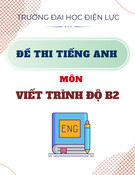


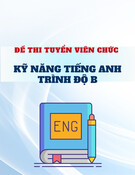



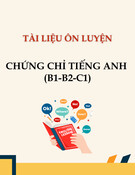
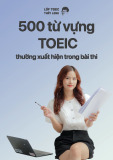
![Tài liệu luyện thi TOEIC cấp tốc trong 10 ngày [chuẩn nhất]](https://cdn.tailieu.vn/images/document/thumbnail/2025/20251029/kimphuong1001/135x160/99661761725822.jpg)
![Tài liệu Phá đảo TOEIC 900+ từ mất gốc trong 30 ngày [Mới nhất]](https://cdn.tailieu.vn/images/document/thumbnail/2025/20251029/kimphuong1001/135x160/2101761720956.jpg)
